2017 MERCEDES-BENZ S-CLASS CABRIOLET roof
[x] Cancel search: roofPage 26 of 521
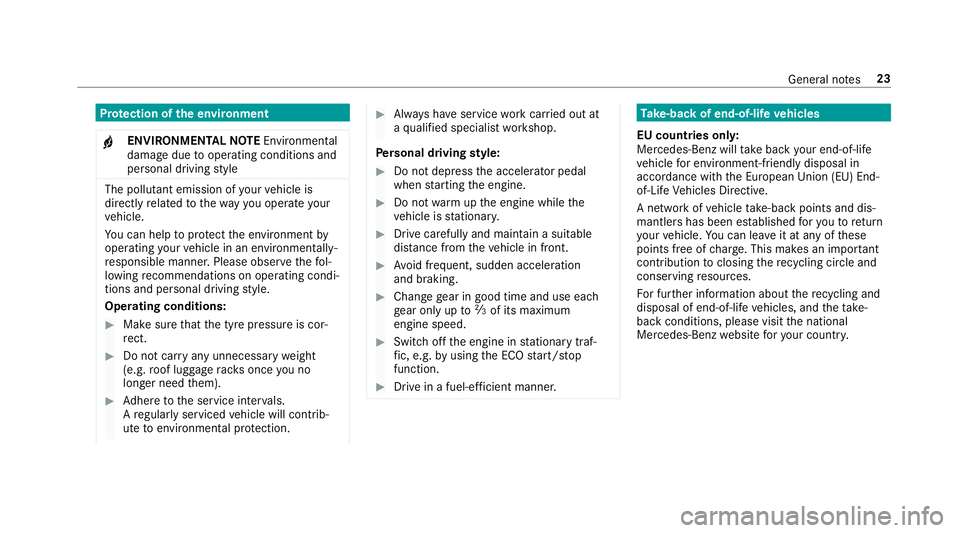
Pr
otection of thee nvironment
+ ENVIRONMENTAL
NOTEEnvironmental
dama gedue tooperating conditions and
personal driving style The pollutant emission of
your vehicle is
directl yrelated tothew ay yo uoperat eyour
ve hicle.
Yo uc an help toprotect thee nvironmen tby
operating your vehicle in an environmentally-
re sponsible manner .Please obser vethef ol‐
lowing recommendations on ope rating condi‐
tions and pe rsonal driving style.
Operating conditions: #
Mak esuret hat thet yrep ressur eisc or‐
re ct. #
Do no tcarry anyu nnecessar yweight
(e.g. roof luggag eracks once youno
lon gern eed them). #
Adher etot he service inter vals.
Ar egularly serviced vehicle will contri b‐
ut etoe nvironmen talp rotection. #
Alw aysh ave service workcar ried out at
aq ualified specialis tworks hop.
Pe rsonal driving style: #
Do no tdepress thea ccelera torp edal
when startin gthe engine. #
Do no twarmupt he engine while the
ve hicle is stationar y. #
Driv ecarefully and maintai nasuita ble
di st anc efromt hevehicle in front. #
Avoid frequent, sudden acceleration
and braking. #
Chang egear in good time and use each
ge ar on lyup toÔ of its maximum
engine speed. #
Switc hoffthee ngine in stationar ytraf‐
fi c, e.g. byusin gthe EC Ostart/s top
function. #
Driv einaf uel-efficient manne r. Ta
ke -bac kofe nd-of-lif evehicles
EU count ries onl y:
Mercedes-Benzw illtak eb acky our end-of-life
ve hicle fore nvironment-friendly disposal in
accordance wit hthe European Union (EU) End-
of-Lif eVehicles Directive.
An etwo rkofvehicle take -ba ckpoint sand dis‐
mantler shas been es tablished fory ou toreturn
yo ur vehicle. Youc an lea veit at an yofthese
points free of charge .T hism akes an impor tant
contribution toclosing ther ecycling circle and
conserving resources.
Fo rfurther information about ther ecycling and
disposal of end-of-lif evehicles, and thet ake-
bac kconditions, please visit then ational
Mercedes-Benz websit efor your count ry. Gene
raln otes 23
Page 59 of 521

Ne
verins tallar ear ward-facing child restra int
sy stem on thef ront passenger seat:
Mak esurey ou obser vethef ollowing informa‐
tion:
R Onforw ard-facin gand rear wa rd-facing child
re stra int sy stems on thef ront passenger seat
(→ pag e58).
R On attaching suitable child restra int sy stems
(→ pag e59). Note
sonf orwa rd-facin gand rear wa rd-facing
ch ild restra int sy stems on thef ront
passenger seat
When using arear ward-facing child restra int sys‐
te mont he front passenger seat, thef ront
passenger front airbag mus talway sbed isabled.
This is onl ythe case if theP ASSENGER AIR BAG
OFF indicator lam pislit continuously
(→ pag e46).
When using thec hild restra int sy stem on the
front passenger seat, it is essentia ltoobserve
th ef ollowing:
R Movethef ront passenger seat as farb ackas
possible.
R Setthe seat backres ttoanalmostvertical
position.
R Retract thes eat cushion lengt hasfar as pos‐
sible.
R Thee ntir ebase of thec hild restra int sy stem
mus talway sr estont he sitting sur face of the
front passenger seat.
R The backres toftheforw ard-facin gchild
re stra int sy stem must, as farasp ossible, be
re sting on thes eat backres tofthe front passenger seat. The
child restra int sy stem
mus tnot to ucht he roof or be put under
st ra in by theh ead restra ints.
R If necessar y,adjus tthe angle of thes eat
backres tand theh ead restra int position
according ly.
R Adjus tthe seat cushion inclination so that
th ef ront edg eofthe seat cushion is in the
highes tposition and ther ear edg eofthe
seat cushion is in thel owest position.
R Alw aysm akes uret hat thes houlder belt
st ra pisc orrectl yr outed from thes eat belt
outle tofthevehicle tothes houlder belt
guide on thec hild restra int sy stem. The
shoulder belt stra pm ustber outed forw ards
and down wardsf romt he seat belt outlet.
R If necessar y,adjus tthe seat belt outle tand
th ef ront passenger seat accordingly.
R Neverp lace objects under or behind the
ch ild restra int sy stem, e.g. cushions.
Alw aysc omply wit hthe manufacturer's ins talla‐
tion and operatin ginstructions fort he child
re stra int sy stem used, and then otes on fitting
suitable child restra int sy stems (→ page59). 56
Occupant saf ety
Page 60 of 521
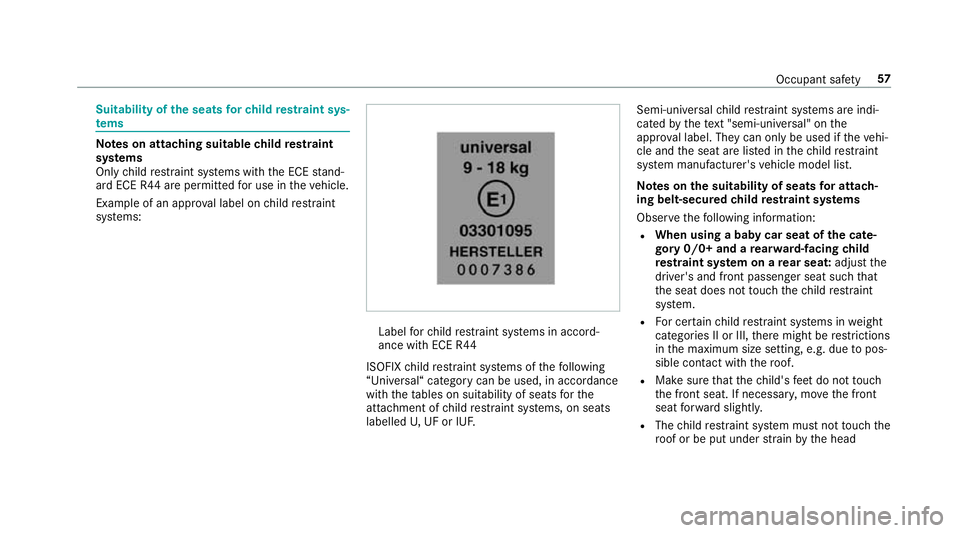
Suitability of
thes eat sfor child restra int sys‐
te ms Note
sona ttaching suitable child restra int
sy stems
Only child restra int sy stems wit hthe ECE stand‐
ar dE CE R4 4arepermit tedf or use in thev ehicle.
Example of an appr oval label on child restra int
sy stems: Label
forc hild restra int sy stems in accord‐
ance wit hECE R44
ISOFIX child restra int sy stems of thef ollowing
“Universal“ categor ycan be used, in accordance
wit hthe tables on suitability of seats fort he
attachment of child restra int sy stems, on seats
labelled U,UF or IUF. Semi-universal
child restra int sy stems ar eindi‐
cated bythet ext" se mi-uni versal" on the
appr oval label. The ycan on ly beused if thev ehi‐
cle and thes eat ar eliste dint hechild restra int
sy stem manufacturer's vehicle model list.
Note sont he suitability of seats fora ttach‐
in gb elt-secured child restra int sy stems
Obser vethef ollowing information:
R When using ababyc ar seat of thec ate‐
gor y0/0+ and arear ward-facing child
re stra int sy stem on arear seat: adjustthe
driver's and front passenger seat suc hthat
th es eat does no ttouc hthe child restra int
sy stem.
R Forc ertain child restra int sy stems in weight
categories II or III ,ther em ight be restrictions
in them aximum size setting, e.g. due topos‐
sible con tact wi th theroof.
R Mak esuret hat thec hild's feet do no ttouch
th ef ront seat. If necessar y,mo vethef ront
seat forw ards lightl y.
R The child restra int sy stem mus tnot to ucht he
ro of or be put under stra in by theh ead Occupant saf
ety57
Page 62 of 521
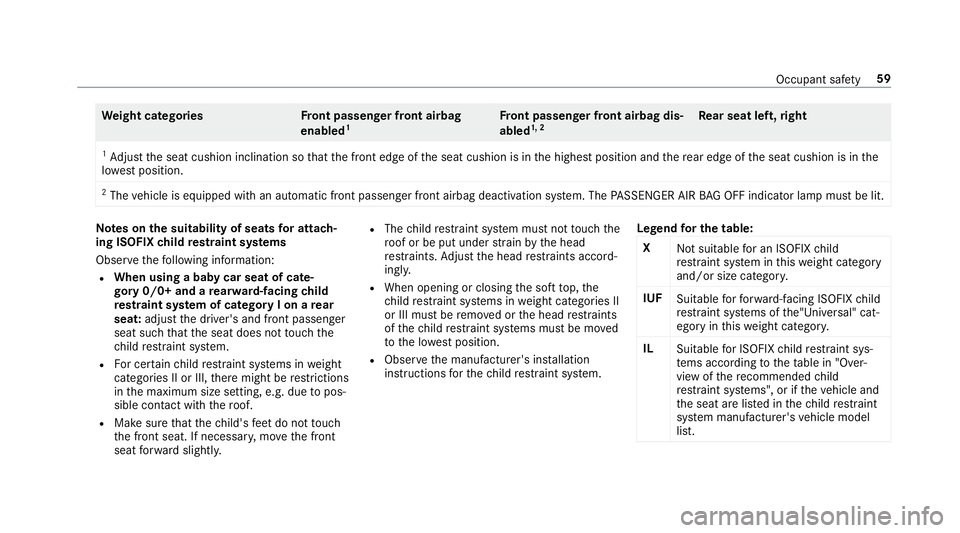
We
ight categories Front passenger front airbag
enabled 1 Fr
ont passenger front airbag dis‐
abled 1, 2 Re
ar seat left, right
1 Ad jus tthe seat cushion inclination so that thef ront edg eofthe seat cushion is in theh ighes tposition and ther ear edg eofthe seat cushion is in the
lo west position.
2 The vehicle is equipped wit hanautomatic front passenger front airbag deactivation sy stem. The PASSENGER AIR BAGO FFindicator lam pmustbel it. Note
sont he suitability of seats fora ttach‐
in gI SOFI Xchild restra int sy stems
Obser vethef ollowing information:
R When using ababyc ar seat of cate‐
gor y0/0+ and arear ward-facing child
re stra int sy stem of categor yIonarear
seat: adjustthe driver's and front passenger
seat suc hthat thes eat does no ttouc hthe
ch ild restra int sy stem.
R Forc ertai nc hild restra int sy stems in weight
categories II or III ,ther em ight be restrictions
in them aximum size setting, e.g. due topos‐
sible con tactwitht he roof.
R Mak esuret hat thec hild's feet do no ttouch
th ef ront seat. If necessar y,mo vethef ront
seat forw ards lightl y. R
The child restra int sy stem mus tnot to ucht he
ro of or be put under stra in by theh ead
re stra ints. Adjus tthe head restra int sa ccord‐
ingly.
R When opening or closing thes oftt op, the
ch ild restra int sy stems in weight categories II
or III mus tberemovedort he head restra ints
of thec hild restra int sy stems mus tbemoved
to thel ow estp osition.
R Obser vethem anufacturer's ins tallation
instructions fort he child restra int sy stem. Legend
fort he table:
X Notsuita blef or an ISOFIXc hild
re stra int sy stem in this we ight category
and/or size categor y.
IUF Suitable forf or wa rd-facin gISOFI Xchild
re stra int sy stems of the"Universal" cat‐
egor yint hisweight categor y.
IL Suitable forI SOFIX child restra int sys‐
te ms according tothet able in "Over‐
vie woft herecommended child
re stra int sy stems", or if thev ehicle and
th es eat ar eliste dint hechild restra int
sy stem manufacturer's vehicle model
list. Occupant saf
ety59
Page 84 of 521
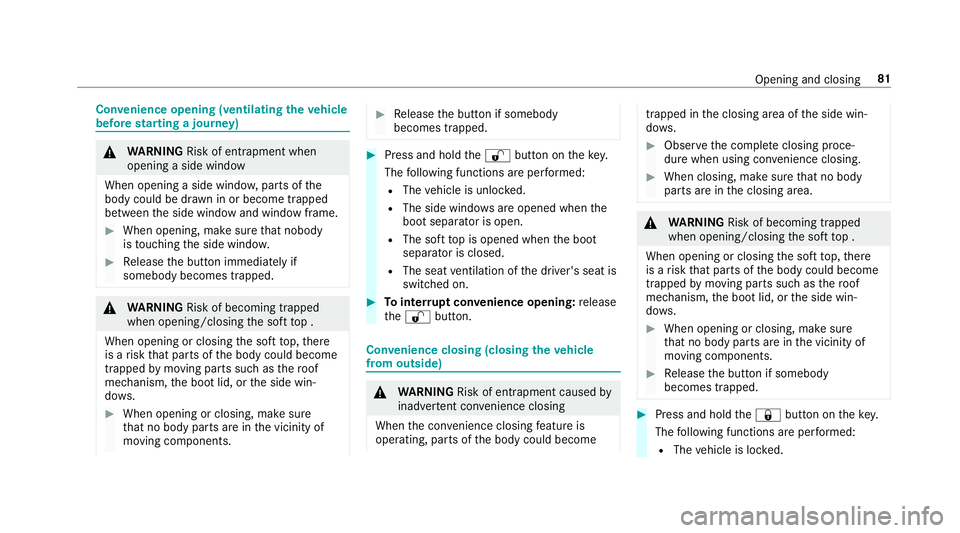
Con
venience opening (ventilating thev ehicle
befor estarting ajourney) &
WARNING Risk of entrapment when
opening asidew indow
Whe nopening asidew indo w, parts of the
body could be dr awninorb ecome trapped
betwee nthe side windo wand windo wframe. #
When opening ,makes uret hat nobody
is touchin gthe side windo w. #
Release theb utton immediatel yif
somebody becomes trapped. &
WARNING Risk of becoming trapped
whe nopening/closing thes oftt op .
When opening or closing thes oftt op, there
is ar isk that parts of theb ody could become
trapped bymoving parts suc hastheroof
mechanism, theb ootlid, or thes ide win‐
do ws. #
When opening or closing, mak esure
th at no body parts ar einthe vicinity of
moving components. #
Release theb utton if somebody
becomes trapped. #
Press and hold the% button on thek ey.
The following function sareper form ed:
R The vehicle is unloc ked.
R The side windo wsareo pened when the
boo tseparator is open.
R The sof ttop is opened when theb oot
separator is closed.
R The seat ventilation of thed rive r's seat is
switched on. #
Tointer rupt convenience opening: release
the % button. Con
venience closing (closing thev ehicle
from outside) &
WARNING Risk of entrapment caused by
inadver tent con venience closing
Whe nthe con venience closing featur eis
operating, parts of theb ody could become trapped in
thec losing area of thes ide win‐
do ws. #
Obser vethec omple teclosing proce‐
du re when using con venience closing. #
Whe nclosing, ma kesur ethat no body
parts ar einthe closing area. &
WARNING Risk of becoming trapped
whe nopening/closing thes oftt op .
When opening or closing thes oftt op, there
is ar isk that parts of theb ody could become
trapped bymoving parts suc hastheroof
mechanism, theb ootlid, or thes ide win‐
do ws. #
When opening or closing, mak esure
th at no body parts ar einthe vicinity of
moving components. #
Release theb utton if somebody
becomes trapped. #
Press and hold the& button on thek ey.
The following function sareper form ed:
R The vehicle is loc ked. Openin
gand closing 81
Page 86 of 521
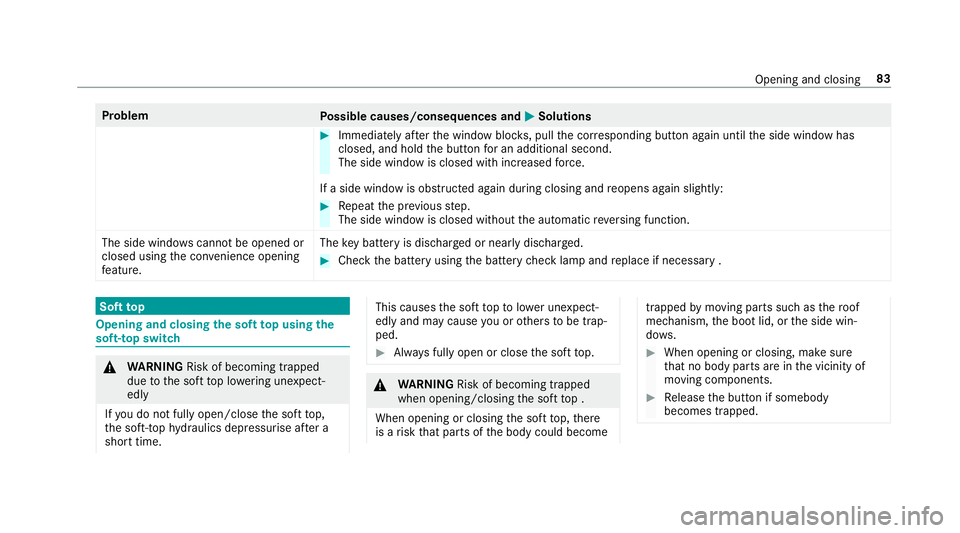
Problem
Possible causes/consequences and M
MSolutions #
Immediatel yafter thew indo wblocks,p ull thec orresponding button again until thes ide windo whas
closed, and hold theb utton forana dditional second.
The side windo wisclosed wit hincrease dforce.
If as ide windo wisobstructed again during closing and reopens again slightly: #
Repeat thep reviou sstep.
The side windo wisclosed without thea utomatic reve rsing function.
The side windo wscanno tbeo pened or
closed using thec onvenience opening
fe ature. The
keyb atte ry is dischar gedorn early dischar ged. #
Chec kthe batter yusing theb atter ychec klam pand replace if necessar y. Sof
ttop Openin
gand closing thes oftt op using the
soft- tops witch &
WARNING Risk of becoming trapped
du etot he sof ttop lo wering unexpect‐
ed ly
If yo udon otfull yopen/close thes oftt op,
th es oft-to phydraulics depressu rise af tera
shor ttime. This causes
thes oftt op tolowe runexpect‐
edly and ma ycausey ou orother stobet rap‐
ped. #
Alw aysf ully open or close thes oftt op. &
WARNING Risk of becoming trapped
whe nopening/closing thes oftt op .
When opening or closing thes oftt op, there
is ar isk that parts of theb ody could become trapped
bymoving parts suc hastheroof
mechanism, theb ootlid, or thes ide win‐
do ws. #
When opening or closing, mak esure
th at no body parts ar einthe vicinity of
moving components. #
Release theb utton if somebody
becomes trapped. Openin
gand closing 83
Page 418 of 521
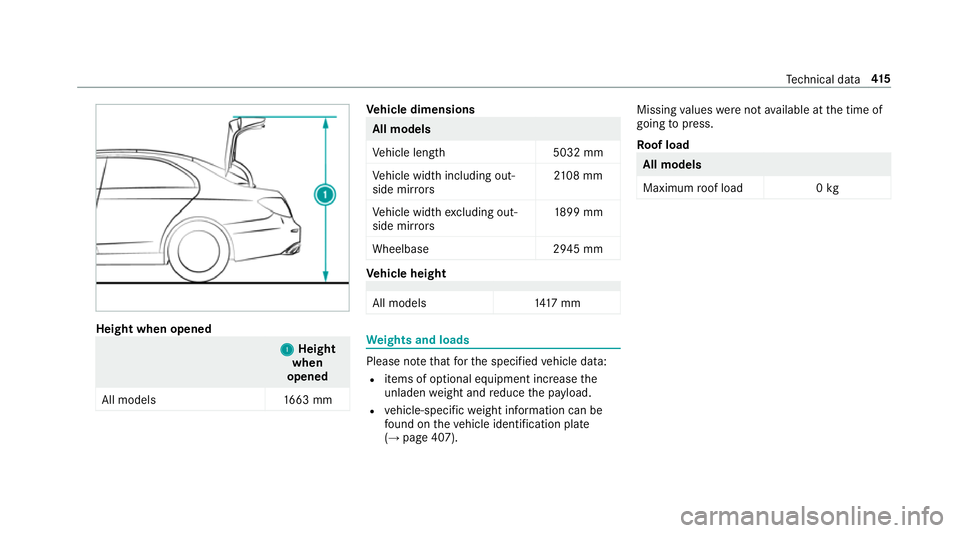
Height wheno
pened 1
1
Height
when
opened
All model s1 663 mm Ve
hicl edimensions All models
Ve
hicle lengt h5 032 mm
Ve hicle widt hincluding out‐
side mir rors 21
08 mm
Ve hicle widt hexcluding out‐
side mir rors 18
99 mm
Wheelbase 2945 mm Ve
hicl eheight All model
s1 417mm We
ight sand loads Please no
tethat fort he specified vehicle data:
R items of optional equipment increase the
unladen weight and reduce thep ayload.
R vehicle-specific weight informatio ncan be
fo und on thev ehicle identification plate
(→ pag e407). Missing
values werenota vailable at thet ime of
going topress.
Ro of load All models
Maximum
roof load 0kg Te
ch nica ldata 415